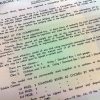Instead of dwelling on the negative, they actually institutionalize this absence as an opportunity for invention (and modeling of national character) by establishing a biannual competition; not for the best structures, but for the most ingenious invention and ‘improvisational use of other materials.’ This is unique. A vast majority of the toy manufacturers represented in the Museum’s collection assert that their toys stimulate creativity and invention, and even challenge their users to be inventors. However, they all struggle mightily to try to define what invention is or to create a tangible framework for how it might occur. The most constructive arguments are made by the manufacturers of early to mid-century engineering sets such as Meccano and Erector when they suggest that users invent means for exploring outer space. Nevertheless, when running engineering and innovation competitions, the very same manufacturers of these toys, such as the A.C. Gilbert Company, awarded their prizes to the most accurate representations of existing everyday life such as battleships and wheelbarrows. The makers of the architectural building sets, prime users of the word ‘invent’ in their literature, fail to use the most basic and American of constructs to describe architectural innovation; the tallest building. And yet with Elland and their wayward Truscale Blocks, we have a compelling challenge, a clear statement of what innovation might be and a process for growing a larger culture of creativity and thoughtful re-use. In this way, the Truscale Blocks are a truly unique and remarkable piece of the Museum’s collection. I have no idea what the end results were of the Elland Company’s regular competitions but, if properly administered and celebrated it’s not hard to imagine either the ‘oohs and aahs’ or the truly meaningful skills gained by the participants. (via National Building Museum Fellowship Update #2: The Merits Of Missing Pieces. | Public Workshop)
